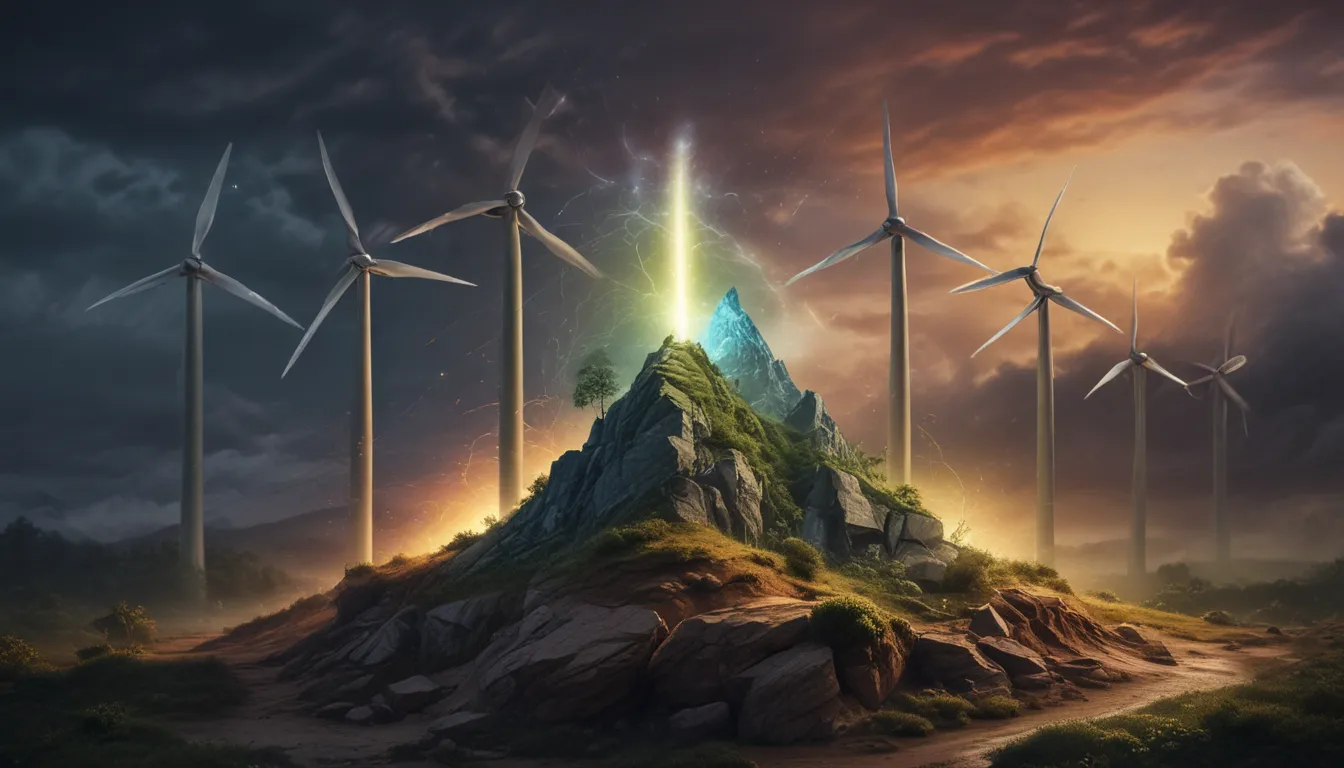A Note About Images: The images used in our articles are for illustration purposes only and may not exactly match the content. They are meant to engage readers, but the text should be relied upon for accurate information.
In today’s world, energy is a fundamental aspect of our daily routines. Whether it’s powering our homes, propelling our vehicles, or driving technological advancements, energy plays a pivotal role in shaping our modern society. While there exists a multitude of energy sources, this article aims to shed light on non-renewable energy sources – those that are either finite or take an exceptionally long time to replenish.
Non-renewable energy sources have stood as the cornerstone of global energy production for centuries. Nevertheless, as we become increasingly aware of the environmental repercussions and the finite nature of these resources, a pressing need arises to pivot towards sustainable, renewable alternatives. Through the exploration of 14 captivating facts about non-renewable energy sources, we will delve into their significance, drawbacks, and the challenges linked to their continued utilization.
The Tale of Non-Renewable Energy Sources:
Non-Renewable Energy Sources are Finite:
Unlike renewable energy sources like solar or wind power, non-renewable energy sources such as coal, oil, and natural gas come with a finite limit. Once these resources are exhausted, they cannot be regenerated, highlighting the critical importance of transitioning towards sustainable solutions.
Non-Renewable Energy Sources Contribute to Climate Change:
The combustion of fossil fuels, a prevalent non-renewable energy source, emits greenhouse gases into the atmosphere, catalyzing global warming and climate change. This poses substantial threats to the planet and the prosperity of future generations.
Non-Renewable Energy Sources: A Historical Legacy:
For centuries, humanity has heavily leaned on non-renewable energy sources, with the Industrial Revolution marking a pivotal juncture in their extensive adoption. The unearthing and utilization of fossil fuels revolutionized various sectors like transportation, manufacturing, and overall livelihoods.
Non-Renewable Energy Sources: A Lucrative Subsidy Scene:
Governments worldwide have historically poured significant subsidies into the non-renewable energy sector to enhance affordability and accessibility. Although these subsidies aim to bolster the industry, they inadvertently perpetuate its dominance in the market.
Non-Renewable Energy Sources and Air Pollution:
The burning of fossil fuels releases harmful pollutants like sulfur dioxide and nitrogen oxide into the air, exacerbating air pollution levels. These detrimental emissions pose risks to human health and the environment at large.
Non-Renewable Energy Sources: An Expensive Extraction Endeavor:
As easily accessible reservoirs of non-renewable energy sources dwindle, the costs associated with their extraction surge. Coupled with escalating demand, this trend poses economic challenges for nations heavily reliant on non-renewable sources.
Non-Renewable Energy Sources: Vital but Risk-Prone Infrastructural Needs:
The extraction, transportation, and storage of non-renewable energy sources necessitate a sophisticated infrastructure network comprising pipelines, refineries, power plants, and distribution systems. These infrastructural facets wield notable environmental and societal impacts.
Non-Renewable Energy Sources: A Geopolitical Chessboard:
Relying on non-renewable energy sources can trigger geopolitical tensions and conflicts. Nations possessing substantial reserves wield significant influence over global energy landscapes, potentially affecting diplomatic ties and global dynamics.
Non-Renewable Energy Sources: Primary Power Players:
Despite the surge in renewable energy, non-renewable sources persist as the primary drivers of electricity generation. Coal and natural gas-powered plants play a pivotal role in meeting global energy demands.
Non-Renewable Energy Sources: A Quandary of Future Supplies:
Estimating the reserves and future supplies of non-renewable energy sources entails grappling with geopolitical factors, technological advancements, and evolving energy policies on a global scale.
Non-Renewable Energy Sources: Health Hazards Unveiled:
The extraction and utilization of non-renewable energy sources harbor adverse effects on human health, with air pollution from fossil fuel combustion linked to respiratory illnesses, cardiovascular diseases, and premature mortality.
Non-Renewable Energy Sources: A Drain on Water Resources:
The extraction and processing of non-renewable energy sources frequently demand substantial water quantities, potentially straining already scarce water reservoirs in certain regions and precipitating environmental and societal repercussions.
Non-Renewable Energy Sources: A Salient Call for Renewable Transitions:
The transition towards renewable energy sources unveils a sustainable resolution to the limitations and drawbacks of non-renewable sources. By investing in renewable technologies and embracing cleaner energy alternatives, we can assuage the adverse impacts linked to non-renewable energy utilization.
In essence, the exploration of these 14 fascinating facts about non-renewable energy sources underscores the challenges, consequences, and prospective solutions entwined with our reliance on finite resources. As we embark on the journey towards a sustainable future, prioritizing investments in renewable energy sources emerges as a critical imperative to mitigate the environmental, economic, and social ramifications of our current energy practices.
Embracing a Green Evolution:
In the grand scheme of energy production and consumption, non-renewable energy sources occupy a significant niche, characterized by an array of intriguing aspects that merit contemplation. From their intrinsic involvement in climate change to their finite nature, comprehending these facets empowers us to make informed choices concerning our energy habits. While non-renewable energy sources have historically underpinned industrial advancements, the exigency to pivot towards sustainable alternatives becomes increasingly apparent with each passing day.
By embracing renewable energy sources and espousing energy-efficient methodologies, we can marshall efforts towards offsetting the adverse consequences associated with non-renewable resources. Whether it’s curbing greenhouse gas emissions or preserving the sanctity of natural landscapes, the paradigm shift towards a cleaner, greener energy future stands as an indispensable facet for the longevity and sustainability of our planet.
FAQs:
-
What are non-renewable energy sources?
Non-renewable energy sources encompass finite resources that cannot naturally replenish at a pace sufficient to meet human demands. Examples include fossil fuels like coal, oil, natural gas, and nuclear energy. -
Why are non-renewable energy sources detrimental to the environment?
Non-renewable energy sources contribute to environmental pollution and climate change through the release of harmful pollutants and greenhouse gases during extraction, processing, and combustion. This leads to air and water pollution, deforestation, and global warming. -
How long will non-renewable energy sources last?
The lifespan of non-renewable energy sources varies based on availability and consumption rates. While estimates project that fossil fuel reserves may endure for several decades, escalating demand poses a threat to depleting these finite resources rapidly. -
Are there alternatives to non-renewable energy sources?
Certainly! Renewable energy sources like solar, wind, hydro, and geothermal energy offer sustainable alternatives to non-renewable sources. These renewable options harness natural processes without depleting finite resources. -
What is the role of non-renewable energy in the global energy mix?
Non-renewable energy sources continue to wield dominance in the global energy mix, accounting for a substantial portion of electricity generation and fuel consumption. Nonetheless, nations worldwide are progressively pivoting towards renewable sources to reduce dependency on non-renewables and assuage environmental impacts. -
Can non-renewable energy sources become sustainable?
While sustained sustainability for non-renewable energy sources proves arduous, technological advancements and efficient resource management can minimize their adverse impact. Implementing carbon capture and storage technologies or adopting cleaner-burning processes represent pivotal strides towards mitigating the environmental fallout of non-renewable energy.
Embracing a greener trajectory not only invigorates the sustainability of our energy practices but also fosters a harmonious coexistence with nature. As we navigate the intricate terrain of global energy dynamics, let us prioritize the transition towards renewable alternatives to ensure a flourishing future for generations to come.
Was this page helpful?
Our unwavering commitment to delivering credible and captivating content is the cornerstone of our ethos. Every nugget of information on our platform is curated by real users like you, aggregating a wealth of diverse insights and knowledge. Through meticulous editorial reviews, we uphold the highest standards of accuracy and reliability, ensuring that the information we disseminate is both engaging and authentic. Rest assured in our dedication to quality and integrity as you embark on an enriching journey of exploration and enlightenment.






